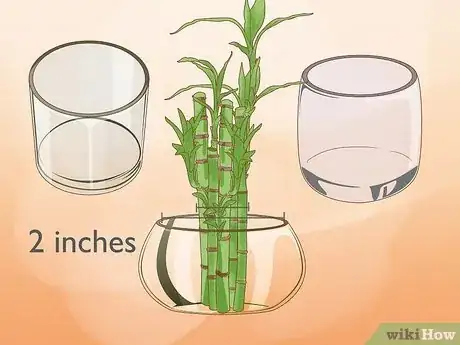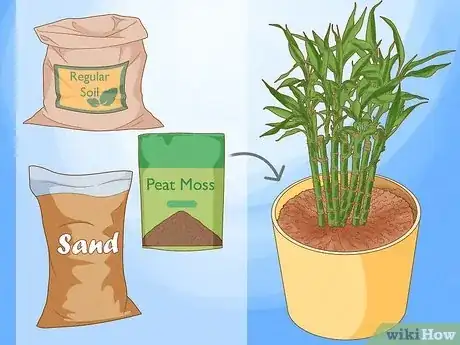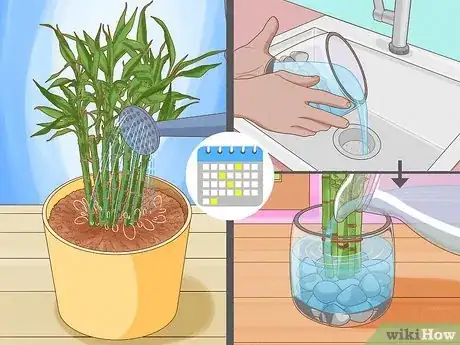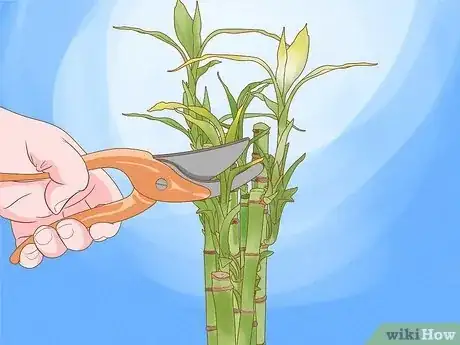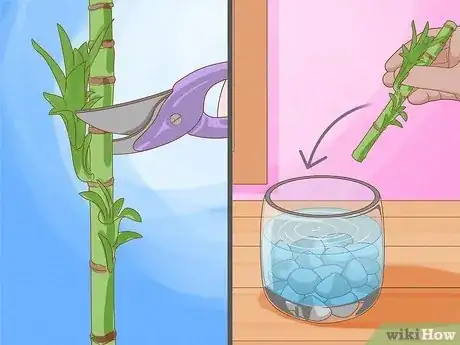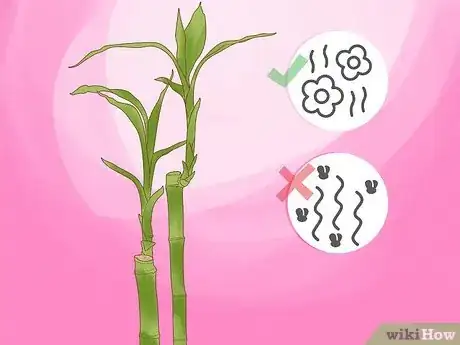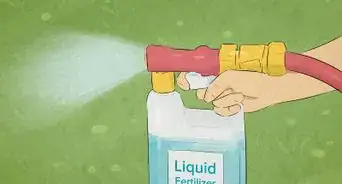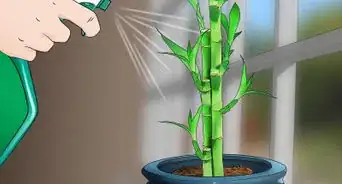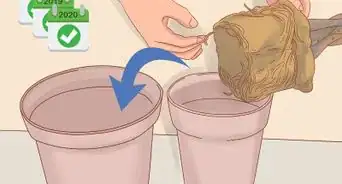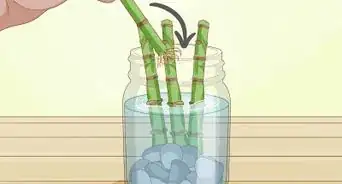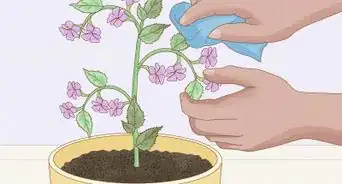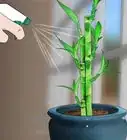This article was co-authored by Lauren Kurtz and by wikiHow staff writer, Dev Murphy. Lauren Kurtz is a Naturalist and Horticultural Specialist. Lauren has worked for Aurora, Colorado managing the Water-Wise Garden at Aurora Municipal Center for the Water Conservation Department. She earned a BA in Environmental and Sustainability Studies from Western Michigan University in 2014.
wikiHow marks an article as reader-approved once it receives enough positive feedback. This article received 168 testimonials and 85% of readers who voted found it helpful, earning it our reader-approved status.
This article has been viewed 2,970,773 times.
Caring for a lucky bamboo plant is a relaxing pastime that's great for reducing stress. This houseplant is simple to take care of, and it's believed that keeping lucky bamboo in your home or office promotes happiness and prosperity. If you’re not sure where to begin properly tending to your lucky bamboo friend, read our handy guide below.
Things You Should Know
- Plant your bamboo in soil or standing water filled with pebbles. Use a small amount of fertilizer to help your bamboo grow stronger, faster.
- Maintain your lucky bamboo by watering once a week and removing dead leaves with scissors.
- When purchasing a bamboo plant, choose a bright green plant, and make sure that it doesn't have a sour odor. This way, you'll know you have a healthy plant.
Steps
Planting Your Lucky Bamboo
-
1Choose a pot 2 inches (5 cm) larger in diameter than the plant. Most lucky bamboo plants already come in a pot, but you can use your own pot to make the plant more your own. If you’re going to plant your bamboo in water, your pot doesn’t need a drainage hole, but if you’re planting in soil, you’ll need a drainage hole to prevent water from building up.[1]
- A clear container works well for water and will show off your plant and pebbles.
-
2Plant your bamboo in soil if you wish. For best results, mix a third each of sand, peat moss, and regular soil to ensure excellent drainage. Be sure to use a pot with a drainage hole to prevent water buildup.[2]
- You can grow your lucky bamboo in standing water or in soil—it’s just a matter of personal preference.
- Water the plant just enough so that the soil is moist. Don’t overwater. Bear in mind that too much soil or fertilization can harm your plant.
Advertisement -
3Place your stalk in standing water, if you don't want to plant in soil. Lucky bamboo can thrive in either soil or a vase, bowl, or jar of standing water. You’ll need some pebbles to hold it upright, and make sure that there is at least enough water to cover the base of the roots.[3]
- Note that tap water contains fluoride and other chemicals that can give your plant “tip burn,” or yellow leaf tips. If you plant your bamboo in water, use bottled or filtered water.
- Alternatively, you can let the tap water sit out for 24 hours to eliminate some of the chemicals before using it for your plant.
-
4Tie the stalks in place with ribbon wire or other ribbon. If you’re planting multiple stalks, a ribbon or wire will help them stay together, especially if you’re planting them in water where there’s a greater tendency for them to slide around among the pebbles.
- People often tie a gold or red ribbon around the stalks of lucky bamboo plants to hold them together, and as an extra symbol of good fortune.
Care and Maintenance
-
1Place the plant in bright, indirect sunlight. Lucky bamboos are hardy houseplants, but they won’t thrive in direct light. Place your potted plant in an area that gets plenty of bright but indirect sun and where the temperature is between 60 degrees F (16 C) and 75 degrees F (24 C).[4]
- Lucky bamboo’s need for indirect light is one reason they’re great office plants: even if you don’t have many windows at your workspace, your lucky bamboo can thrive.
- Keep the plant in a spot where the temperature is stable.
-
2Water the plant or change the water weekly. Whether your plant is growing in soil or in standing water, it’ll need fresh water about once a week. However, be careful not to overwater it, as these plants really don’t need much water to thrive.[5]
- If your plant is growing in water, rinse the vase, pebbles, and plant each time you change the water.
- If your plant is growing in water, it's essential to refresh the water regularly to prevent the plant from rotting.
-
3Add a very light fertilizer every 2 months or so for quicker growth. Too much fertilizer is worse than none at all, so use it sparingly. For a plant growing in soil, use manure or compost. If your plant is growing in water, use a few drops of water-soluble fertilizer.[6]
- It is especially important not to overfertilize potted plants because the fertilizer will not become diluted by rain and can’t run off like it will for plants in the ground.
- Check the NPK value of the fertilizer you use. NPK refers to the ratio of nitrogen, phosphorous, and potassium in a fertilizer. The NPK ratio for lucky bamboo fertilizer should be 2 to 2 to 2.
- If you can, use organic fertilizer. Many synthetic fertilizers contain salts and high phosphorous concentrations that can cause tip burn.[7]
-
4Train your stalks to grow in specific shapes if you wish. To curl your lucky bamboo plant, get a cardboard box and cut off the bottom and one side. Place the box over your plant with the open end facing your light source. Your stalks will begin to curl towards the light as they grow. Once you see a bend, rotate your plant.[8]
- Begin with younger stalks: they are suppler than older stalks and therefore easier to shape.
- You can also wrap some wire around younger stalks, crisscrossing them. As they grow, they’ll intertwine to form a trellis shape. Keep adding wire as they grow to support them.
-
5Use scissors or shears to remove dead or yellow leaves when they appear. Sometimes the ends of your leaves might turn yellow. To remove the yellowed tips of your leaves, sterilize a pair of pruning shears or sharp scissors with light rubbing alcohol or vinegar, then cut the yellow part off following the natural shape of the leaf. You can trim off the yellow parts, or remove the whole leaf.
- Burned tips could be caused by a few factors: your plant isn’t getting enough water, there’s too much soil or fertilizer, or your plant’s getting too much direct sunlight.
- You can remove whole leaves by simply pulling them down off the stalk at the base of the leaf.
-
6Take cuttings if you want to propagate your plant. When one or two of your stalks gets too tall, you can remove the extra stalks, set them in water, wait for them to grow new roots, and then pot them according to the above instructions. Propagating your lucky bamboo plant doesn’t just give you double (or triple!) the plants; it helps ensure your plant doesn’t get too crowded in its pot.
- Take your longest stalk and remove the smaller leaves at the top of the shoot.
- With a sterile knife or scissors, cut the shoot so at least two nodes, which are the raised part of the stem, are on the new cutting.
- Place the shoot in a bowl of clean, distilled water. Keep it in a shady area for about one to two months until it begins to sprout roots. Once you see roots, you can plant your new lucky bamboo.
- You can also propagate your plant if the main plant has begun to die. Rather than toss the whole plant out, cut off healthy growth and replant them.
-
7Repot your plant when it grows too big. Your lucky bamboo will eventually outgrow its container. This may take a year or so. You'll know it needs to be repotted when the stalks begin crowding the pot (if your plant is growing in a clear container, you'll be able to see tight root growth beneath the surface). Gently remove the plant from the container, being careful not to damage the roots, and repot it in a new container 2 inches (5 cm) larger in diameter than the plant.[9]
- If your plant is growing in standing water, its roots may have tangled around the pebbles; gently cut away the roots if you cannot untangle them from the pebbles.
- If you want, you can divide your plant into multiple plants. Use your shears to cut through the root ball to divide your stalks and plant them in separate containers.
- If you are transferring a plant that was growing in water to soil, keep the soil moist for the first 2 weeks to allow the plant to acclimate. After 2 weeks, only water when the top inch or so of soil feels dry.
Selecting a Lucky Bamboo Plant
-
1Choose a lucky bamboo plant with vibrant green foliage. You can find lucky bamboo plants at your local garden center or nursery, and even some grocery stores. However, finding a healthy plant may take a bit of time. Caring for a lucky bamboo plant isn’t very hard, but if you get one that isn’t healthy, it will be much harder to care for and it may die. Healthy plants will be bright green all the way through—that is, their leaves won’t be yellow-tipped and they won’t have any yellowing or bruises.[10]
- The plant may be labeled one of the following ways: Lucky Bamboo, Ribbon Plant, or occasionally its true name, Dracaena sanderiana.
-
2Opt for a plant that is smooth and sturdy. A healthy plant will not be wilted or wrinkly. The size of the plant doesn’t matter too much here, but if your plant is drooping or wrinkly, it’s a sign the plant is probably sick.[11]
- If you’re planning to train your bamboo at home, you want a younger plant. Younger plants will be bendier than more mature plants, but they should still be smooth and unwrinkled, and they should still stand straight.
-
3Pick a plant that has been planted properly and doesn’t smell. Lucky bamboo plants are very resilient, but if they have been planted incorrectly or have a sour odor, they could be sick, and won’t grow. Even if you plan to repot your plant at home, it should still be properly planted when you adopt it to ensure it’s healthy.[12]
- Bamboo plants don’t have a fragrance like flowers do, but if they haven’t been watered properly, they can grow bacteria and develop a stink.
- Check the current water levels, and check to see if it has soil or fertilization. Many bamboo plants are grown hydroponically, just in water with small rocks or pebbles to hold the stalks in place. Some may be in soil; however, check to make sure that it is at least half full of water, or the soil is moist, but not soaked.
Expert Q&A
-
QuestionWhat should I do if the bottom of the plant that is in the water looks black?
 Lauren KurtzLauren Kurtz is a Naturalist and Horticultural Specialist. Lauren has worked for Aurora, Colorado managing the Water-Wise Garden at Aurora Municipal Center for the Water Conservation Department. She earned a BA in Environmental and Sustainability Studies from Western Michigan University in 2014.
Lauren KurtzLauren Kurtz is a Naturalist and Horticultural Specialist. Lauren has worked for Aurora, Colorado managing the Water-Wise Garden at Aurora Municipal Center for the Water Conservation Department. She earned a BA in Environmental and Sustainability Studies from Western Michigan University in 2014.
Professional Gardener This is probably root rot. If you plant isn’t already dead, replace the old water with fresh water at least weekly. Use dechlorinated water by letting tap water sit out for at least 24 hours before using it.
This is probably root rot. If you plant isn’t already dead, replace the old water with fresh water at least weekly. Use dechlorinated water by letting tap water sit out for at least 24 hours before using it. -
QuestionMy lucky bamboo plant has jelly-like substances at the roots. Is it okay to leave them?
 Lauren KurtzLauren Kurtz is a Naturalist and Horticultural Specialist. Lauren has worked for Aurora, Colorado managing the Water-Wise Garden at Aurora Municipal Center for the Water Conservation Department. She earned a BA in Environmental and Sustainability Studies from Western Michigan University in 2014.
Lauren KurtzLauren Kurtz is a Naturalist and Horticultural Specialist. Lauren has worked for Aurora, Colorado managing the Water-Wise Garden at Aurora Municipal Center for the Water Conservation Department. She earned a BA in Environmental and Sustainability Studies from Western Michigan University in 2014.
Professional Gardener Some store bought bamboo plants come with water absorbing gel to keep the plant watered while it is at the store. This can be left in place or washed off during repotting.
Some store bought bamboo plants come with water absorbing gel to keep the plant watered while it is at the store. This can be left in place or washed off during repotting. -
QuestionI bought a lucky bamboo, and it came curled. Will it stay that way as it grows?
 wikiHow Staff EditorThis answer was written by one of our trained team of researchers who validated it for accuracy and comprehensiveness.
wikiHow Staff EditorThis answer was written by one of our trained team of researchers who validated it for accuracy and comprehensiveness.
Staff Answer wikiHow Staff EditorStaff AnswerLucky bamboo naturally grows straight, but you can train your bamboo to grow into a certain shape by manipulating its access to light. If you've bought a lucky bamboo plant that's already shaped, the curly stalk will stay in place, but the stalk will not continue to curl as it grows unless you keep up the light source manipulation. If the curly stalk dies off and a new one begins to grow, it will not automatically grow curly.
wikiHow Staff EditorStaff AnswerLucky bamboo naturally grows straight, but you can train your bamboo to grow into a certain shape by manipulating its access to light. If you've bought a lucky bamboo plant that's already shaped, the curly stalk will stay in place, but the stalk will not continue to curl as it grows unless you keep up the light source manipulation. If the curly stalk dies off and a new one begins to grow, it will not automatically grow curly.
Things You'll Need
- Scissors or pruning shears
- A pot or container 2 inches (5 cm) bigger in diameter than the plant
- Soil (optional)
- Fertilizer (optional)
- Purified water (optional)
References
- ↑ https://www.goodhousekeeping.com/home/gardening/a20705678/growing-lucky-bamboo/
- ↑ https://www.gardenersworld.com/how-to/grow-plants/how-to-grow-lucky-bamboo/
- ↑ https://www.gardenersworld.com/how-to/grow-plants/how-to-grow-lucky-bamboo/
- ↑ https://www.gardenersworld.com/how-to/grow-plants/how-to-grow-lucky-bamboo/
- ↑ https://www.bhg.com/gardening/houseplants/care/what-is-the-best-way-to-repot-a-lucky-bamboo-plant/
- ↑ https://plantscraze.com/fertilizers-to-use-for-lucky-bamboo/
- ↑ https://www.goodhousekeeping.com/home/gardening/a20705678/growing-lucky-bamboo/
- ↑ http://www.gardenguides.com/125532-instructions-curl-lucky-bamboo-wire.html
- ↑ https://www.bhg.com/gardening/houseplants/care/what-is-the-best-way-to-repot-a-lucky-bamboo-plant/
About This Article
To take care of lucky bamboo, place your plant in bright, indirect sunlight. Avoid keeping it in direct sunlight since the leaves could burn. If you’re growing your lucky bamboo in water, make sure there’s always enough water in the container to cover the roots. Change out the water once per week so the roots don’t start to rot. If you’re growing your lucky bamboo in soil, water it whenever the soil starts to dry out, or about once a week. Water it lightly so the soil is moist but not soaked. If the leaves on your plant turn yellow, it could mean it’s not getting enough water or it’s getting too much sunlight. You can trim off yellow leaves with sterilized scissors to keep your lucky bamboo looking green and healthy.
